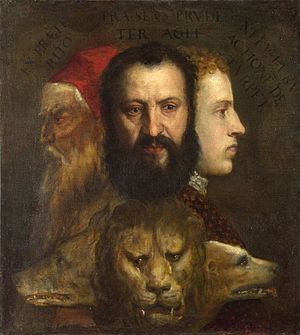Time



Time (Greek: Χρόνος chronos; Latin: tempus) appears to us today in earthly experience as an unstoppable, irreversible, linear sequence of events directed from the past through the present into the future. Arthur Stanley Eddington (1882-1944) coined the term arrow of time[1] for this in the Gifford Lectures he gave in 1927, which gives the time axis a clear irreversible direction in spatiotemporal diagrams.
In contrast, the ancient mythologies were based on a cyclical model of time, which has its origins in the experience of the course of the year. Closely connected to the concept of time is the concept of temporality as an expression of the unstoppable, irreversible changeability and transience of the physical world, which is understood as a process of development characterised by constant becoming and passing away. Temporality is thus an opposite concept to the eternity and imperishability of the higher spiritual world. In the Old Testament, temporality and especially death are interpreted as the consequence of the Fall of Man.
From an anthroposophical point of view, what we experience as time has its true cause in the interaction of a sum of lower and higher spiritual beings.
Augustine on the riddle of time
„So what is time? If no one asks me about it, I know, but if I should explain it to one who asks me, I do not know; with confidence, however, I can at least say that I know that if nothing passed, there would be no past time, and if nothing passed, there would be no future time. those two times, then, past and future, how can one say that they are, if the past has already ceased to be and the future is not yet? If, on the other hand, the present were always present, and did not pass into the past, it would no longer be time, but eternity.“
Literature
- Julius Thomas Fraser: Die Zeit: Vertraut und Fremd, Birkhäuser-Verlag, Basel Boston Berlin 1988, ISBN 978-3764319908
- Manfred Osten: „Alles veloziferisch“ oder Goethes Entdeckung der Langsamkeit, Wallstein Verlag 2013, ISBN 978-3835313866, eBook ASIN B00E4SYQ8Q
- John Ellis McTaggart: The Unreality of Time, in: Mind, Volume XVII, Issue 4, 1 January 1908, pp. 457–474 doi:10.1093/mind/XVII.4.457 pdf
- Brigitte Falkenburg: Mythos Determinismus: Wieviel erklärt uns die Hirnforschung?, Springer-Verlag 2012; ISBN 978-3642250972; eBook B00A9YG6J6 ASIN B00A9YG6J6
- Alexander Unzicker: Die mathematische Realität: Warum Raum und Zeit eine Illusion sind, Selbstverlag, 2019, ISBN 978-1713256168, eBook ASIN B082PVP95T
- Hilary Putnam: Time and Physical Geometry, in: The Journal of Philosophy, Vol. 64, No. 8 (Apr. 27, 1967) doi:10.2307/2024493 pdf
- Carlo Rovelli: Die Ordnung der Zeit, Rowohlt Buchverlag 2018, ISBN 978-3498053994, eBook ASIN B07CP2F7B7
- Carlo Rovelli: Und wenn es die Zeit nicht gäbe?: Meine Suche nach den Grundlagen des Universums, Rowohlt Taschenbuch 2018, ISBN 978-3499633881, eBook ASIN B077JL4RXP
- Georg Kniebe (Hrsg.), Gunther Hildebrandt, Georg Maier: Was ist Zeit? Die Welt zwischen Wesen und Erscheinung, Verlag Freies Geistesleben, Stuttgart 2000, ISBN 978-3772518768
- Christoph J. Hueck: Evolution im Doppelstrom der Zeit: Die Erweiterung der naturwissenschaftlichen Entwicklungslehre durch die Selbstanschauung des Erkennens, Verlag am Goetheanum, Dornach 2012, ISBN 978-3723514689
- Wilhelm Hoerner: Zeit und Rhythmus - Die Ordnungsgesetze der Erde und des Menschen, 6. Auflage, Verlag Urachhaus, 2017, ISBN 978-3878382416
- Andreas Neider: Der Mensch und das Geheimnis der Zeit: Zum Verständnis der Zeit im Werk Rudolf Steiners, Verlag Freies Geistesleben, Stuttgart 2016, ISBN 978-3772519086; eBook ASIN B01N97G2BO
- Rudolf Steiner: Metamorphosen des Seelenlebens – Pfade der Seelenerlebnisse. Zweiter Teil, GA 59 (1984), ISBN 3-7274-0595-3 English: rsarchive.org German: pdf pdf(2) html mobi epub archive.org
- Rudolf Steiner: Die Ergänzung heutiger Wissenschaften durch Anthroposophie, GA 73 (1987), ISBN 3-7274-0730-1 English: rsarchive.org German: pdf pdf(2) html mobi epub archive.org
- Rudolf Steiner: Damit der Mensch ganz Mensch werde, GA 82 (1994), ISBN 3-7274-0820-0 English: rsarchive.org German: pdf pdf(2) html mobi epub archive.org
- Rudolf Steiner: Vor dem Tore der Theosophie, GA 95 (1990), ISBN 3-7274-0952-5 English: rsarchive.org German: pdf pdf(2) html mobi epub archive.org
- Rudolf Steiner: Die Apokalypse des Johannes, GA 104 (1985), ISBN 3-7274-1040-X English: rsarchive.org German: pdf pdf(2) html mobi epub archive.org
- Rudolf Steiner: Aus der Bilderschrift der Apokalypse des Johannes, GA 104a (1991), ISBN 3-7274-1045-0 English: rsarchive.org German: pdf pdf(2) html mobi epub archive.org
- Rudolf Steiner: Geistige Hierarchien und ihre Widerspiegelung in der physischen Welt, GA 110 (1981)
- Rudolf Steiner: Der Orient im Lichte des Okzidents. Die Kinder des Luzifer und die Brüder Christi., GA 113 (1982), Neunter Vortrag, München, 31. August 1909
- Rudolf Steiner: Anthroposophie – Psychosophie – Pneumatosophie, GA 115 (2001), ISBN 3-7274-1150-3 English: rsarchive.org German: pdf pdf(2) html mobi epub archive.org
- Rudolf Steiner: Exkurse in das Gebiet des Markus-Evangeliums, GA 124 (1995), ISBN 3-7274-1240-2 English: rsarchive.org German: pdf pdf(2) html mobi epub archive.org
- Rudolf Steiner: Die Evolution vom Gesichtspunkte des Wahrhaftigen, GA 132 (1987), Erster Vortrag, Berlin, 31. Oktober 1911 English: rsarchive.org German: pdf pdf(2) html mobi epub archive.org
- Rudolf Steiner: Von der Initiation. Von Ewigkeit und Augenblick. Von Geisteslicht und Lebensdunkel., GA 138 (1986) English: rsarchive.org German: pdf pdf(2) html mobi epub archive.org
- Rudolf Steiner: Okkultes Lesen und okkultes Hören, GA 156 (2003), ISBN 3-7274-1561-4 English: rsarchive.org German: pdf pdf(2) html mobi epub archive.org
- Rudolf Steiner: Kunst- und Lebensfragen im Lichte der Geisteswissenschaft, GA 162 (2000), ISBN 3-7274-1620-3 English: rsarchive.org German: pdf pdf(2) html mobi epub archive.org
- Rudolf Steiner: Zufall, Notwendigkeit und Vorsehung , GA 163 (1986), ISBN 3-7274-1630-0 English: rsarchive.org German: pdf pdf(2) html mobi epub archive.org
- Rudolf Steiner: Die Verbindung zwischen Lebenden und Toten, GA 168 (1995), ISBN 3-7274-1680-7 English: rsarchive.org German: pdf pdf(2) html mobi epub archive.org
- Rudolf Steiner: Die spirituellen Hintergründe der äußeren Welt. Der Sturz der Geister der Finsternis, GA 177 (1999), ISBN 3-7274-1771-4 English: rsarchive.org German: pdf pdf(2) html mobi epub archive.org
- Rudolf Steiner: Die Polarität von Dauer und Entwickelung im Menschenleben. Die kosmische Vorgeschichte der Menschheit., GA 184 (2002), ISBN 3-7274-1840-0 English: rsarchive.org German: pdf pdf(2) html mobi epub archive.org
- Rudolf Steiner: Die Brücke zwischen der Weltgeistigkeit und dem Physische des Menschen, GA 202 (1993), ISBN 3-7274-2020-0 English: rsarchive.org German: pdf pdf(2) html mobi epub archive.org
- Rudolf Steiner: Menschenwesen, Menschenschicksal und Welt-Entwickelung, GA 226 (1988), ISBN 3-7274-2260-2 English: rsarchive.org German: pdf pdf(2) html mobi epub archive.org
- Rudolf Steiner: Anthroposophie – Eine Zusammenfassung nach einundzwanzig Jahren, GA 234 (1994), ISBN 3-7274-2342-0 English: rsarchive.org German: pdf pdf(2) html mobi epub archive.org
- Rudolf Steiner, Marie Steiner-von Sivers: Briefwechsel und Dokumente 1901–1925, 2., völlig überarbeitete und erweiterte Auflage, GA 262 (2002), ISBN 3-7274-2620-9 English: rsarchive.org German: pdf pdf(2) html mobi epub archive.org
- Rudolf Steiner: Das Zusammenwirken von Ärzten und Seelsorgern, GA 318 (1994), ISBN 3-7274-3181-4 English: rsarchive.org German: pdf pdf(2) html mobi epub archive.org
- Rudolf Steiner: Die vierte Dimension, GA 324a (1995), ISBN 3-7274-3245-4 English: rsarchive.org German: pdf pdf(2) html mobi epub archive.org
- Rudolf Steiner: Vorträge und Kurse über christlich-religiöses Wirken, V: Apokalypse und Priesterwirken, GA 346 (2001), ISBN 3-7274-3460-0 English: rsarchive.org German: pdf pdf(2) html mobi epub archive.org
- Beiträge zur Rudolf Steiner Gesamtausgabe, Heft 49/50: Die Rechtfertigung der geistigen Wirklichkeit vor dem modernen Bewusstsein. Zum Gedenken des 50. Todestages von Rudolf Steiner Beiträge (Contributions) 49/50
- Beiträge zur Rudolf Steiner Gesamtausgabe, Heft 63: Rudolf Steiner über den Atomismus. Zwei Aufsätze aus dem Frühwerk Beiträge (Contributions) 63
 |
References to the work of Rudolf Steiner follow Rudolf Steiner's Collected Works (CW or GA), Rudolf Steiner Verlag, Dornach/Switzerland, unless otherwise stated.
Email: verlag@steinerverlag.com URL: www.steinerverlag.com. Index to the Complete Works of Rudolf Steiner - Aelzina Books A complete list by Volume Number and a full list of known English translations you may also find at Rudolf Steiner's Collected Works Rudolf Steiner Archive - The largest online collection of Rudolf Steiner's books, lectures and articles in English. Rudolf Steiner Audio - Recorded and Read by Dale Brunsvold steinerbooks.org - Anthroposophic Press Inc. (USA) Rudolf Steiner Handbook - Christian Karl's proven standard work for orientation in Rudolf Steiner's Collected Works for free download as PDF. |
References
- ↑ A. Eddington: Space Time and Gravitation. Cambridge University Press 1920
